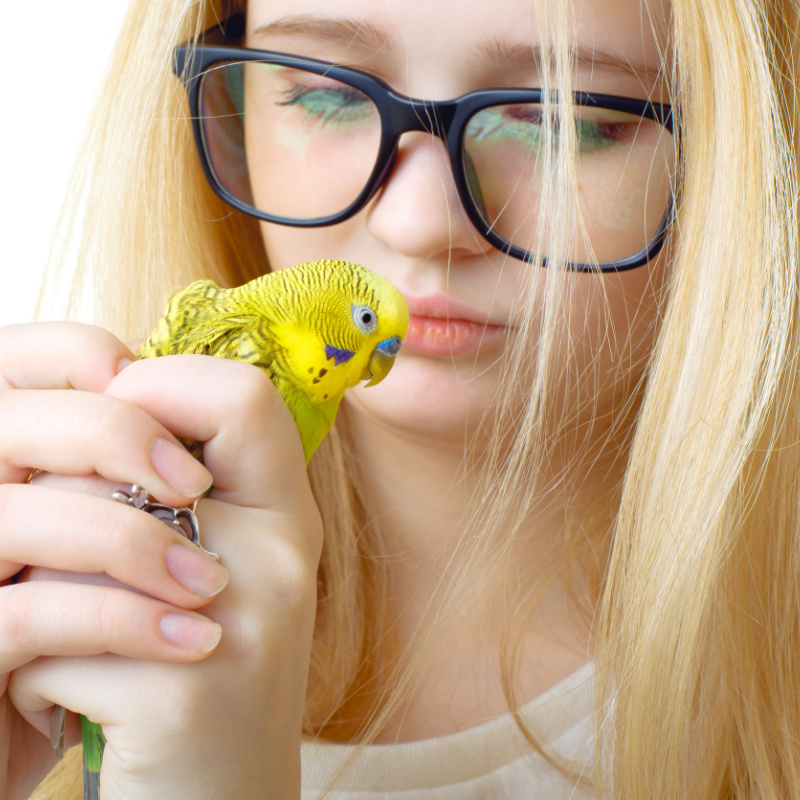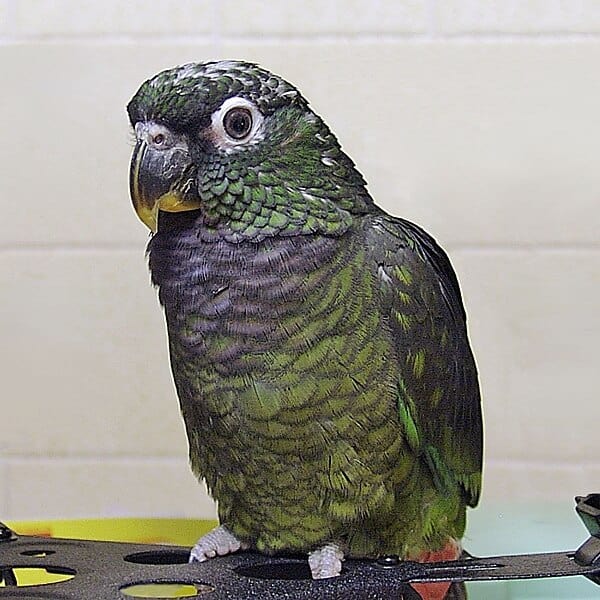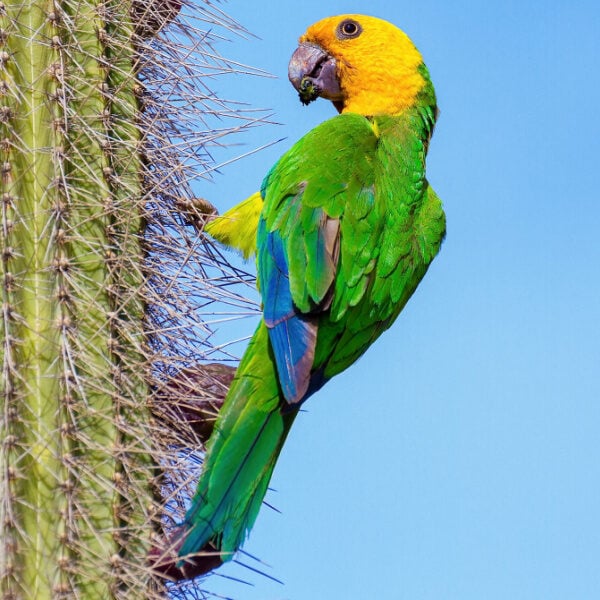
The Magic of Bird Eye Sight and Challenges of Blind Bird Care
Last Updated on by Mitch Rezman
Pet bird features
- Body mechanisms that put a Swiss watch to shame
- A coat of thousands of feathers requiring constant maintenance
- Eyes that see invisible (to you & me) light
- Beaks that can crack large nuts or hull tiny seeds
- Use of flight to travel 3 dimensionally throughout your home
- Can land then stand on any 3 square inch surface
- Knows what time it is – precisely
- Can detect the motion of the sun
- Solves problems
- (Some) can verbalize
- Can pre-plan events into the future
- Can do all of this for decades
makes caged bird keeping the most challenging of traditional pet husbandry.
The science of bird sight
Good eyesight is imperative for flight safety and birds eyesight is much better than that of any other species having vertebrae. It’s been said that pigeons are nothing more than two eyes and a pair of wings. Birds eyes are similar to that of reptiles, meaning the shape of the lens can change quickly, much more quickly than we mammals.Birds have the largest eyes relative to their body size of any animal on the planet. Raptors have very large eyes for their size, 1.4 times greater than the average for birds of the same weight, and the eye is tube-shaped to produce a larger retinal image. But the movement of the eye is limited because birds eyes have a bony socket. Most vertebrates have two eye lids, birds have a third transparent membrane that is movable which is unique to birds.
Birds have four types of color receptors in the eye (unlike humans who have 3). That means birds are able to see the ultraviolet part of the light spectrum – light that is not visible to you nor I. They also have far more light receptors in their retinas than mammals and more nerve connections between the photoreceptors in the brain. This is why proper lighting for your bird is so important.
The four pigments in a bird’s cones extend the range of color vision into the ultraviolet.
Many birds in the wild show plumage patterns that are actually ultraviolet and invisible to we humans. Some birds who appear to be monomorphic (cannot tell the sex of the bird by their colors) to the naked eye can be sexually distinguished by the presence of ultraviolet reflective patches on their feathers – but only by other birds.
Birds can also resolve rapid movements of light far better than humans. Neither you nor I can distinguish the individual flashes of a florescent light oscillating at 60 Hz BUT Budgerigars and chickens have flicker thresholds at more than 100 Hz. A Cooper’s Hawk can pursue prey through heavily forested woodland, avoiding collisions at high speeds which If you are I were to try to keep up – would all appear as a blur.
Birds can even detect the motion of extremely slow-moving objects like the sun and constellations across the sky (think GPS attached to an altimeter but covered in feathers). Another thing humans cannot do without sophisticated instruments. Centuries ago, things like sextants (John Bird made the first sextant in 1757) were needed to figure out “where am I on the planet?” This 3-dimensional geographical accuracy is instinctive to our feathered companions. Birds use celestial movements to properly orient themselves in relation to the earth’s surface.
Birds of prey have a very high density of receptors that gives them acute vision. From flying Falcons, I have learned a falcon can see a “mouse at a mile” Nocturnal species of birds have tubular eyes with few color detectors, but more night cells that help vision in poor light. Many seabirds actually have red or yellow oil drops in the color receptors that are used to improve vision, especially in foggy conditions – I wear amber goggles while riding my motorcycle on overcast days for the same reason.
Most birds cannot move the eye a cormorant being an exception. Many birds have eyes on the sides of their heads because it provides a wider field of vision useful for predator lookouts. Birds with eyes in the front their heads like owls have what is called “binocular” vision, which makes them excellent hunters because they can estimate distance precisely.
The eye is kept clean by tear secretions from the lachrymal gland and protected by an oily substance from the Harderian glands which coats the cornea and prevents dryness. These substances lubricate the eyes when blinking. The third concealed eyelid (nictitating membrane) that we talked about earlier, sweeps across the eye horizontally like an automobile’s windshield wiper acting as a “lubrication delivery system”. This membrane covers the eye and acts as a “contact lens” for aquatic birds while underwater. In most birds the lower eyelid rises to cover the eye when sleeping.
Studies have shown that many bird species focus on distant objects and will orient themselves sideways to help maximize visual resolution. For a pigeon, the resolution is twice as good with sideways monocular vision as forwarding binocular vision, whereas for humans the converse is true.
Some causes of bird blindness
There are many reasons a bird can go blind. Eye injury, eye infection or the side effects of other medical problems. One of most common disorders is conjunctivitis. This is where uveitis will inflame the inner parts of the bird’s eyes and needs to be addressed quickly by a veterinarian to avoid the formation of cataracts.
Marek’s disease is caused by a viral infection and will cause the birds pupils to be shaped irregularly leading to Iritis Blindness. It could also possibly lead to cancer. This can be prevented with a veterinary vaccination.
Another viral infection found in birds is called Avian Pox. Symptoms include swelling and blister-like formations of the eyelids which can lead to partial or complete vision loss. If the infection is treated vision can return.
Bacterial infections like salmonella can cause conjunctivitis and ophthalmitis yielding an inflamed eyeball with pus and conjunctiva sometimes leading to blindness. Salmonella is contagious and can spread from adult to young bird even through egg yolk.
Moldy seed is another reason we advocate never buying bulk food in pet shops or re-bagged bird food online (all our bird food is sold in factory sealed bags) as mold (caused by not emptying the bulk bird food bins and not sanitizing them between bin refills) can cause fungal eye infections leading to disorders of bird’s eyes. The most common is Aspergillus which infects the birds respiratory system, but can also lead to compromised eyes and even problems with the brain.
Immune suppression can also lead to Aspergillus infections. Immune suppression can be caused by stress,Vitamin A deficiency (common with an all seed diet) and prolonged use of antibiotics. If you see yellow plaque under the eyelid and inflammation you must get it treated rapidly by a veterinarian because it can result in long-lasting eye damage. Aspergillus is also difficult & complicated to test for but if your bird exhibits respiratory distress, take that as a warning sign.
Interestingly, if a breeding bird is deficient in Vitamin E the result might be a blind-at-birth, chick. Vitamin A is necessary to help bird’s eye’s tear and for proper pigmentation. This is where engineered foods a.k.a. pellet bird foods are able to ensure that your bird gets all the necessary vitamins without guesswork.
Recommendations for dealing with a blind or disabled bird
A customer of ours is rescuing a blind Senegal parrot and reached out to us for advice. Here are our recommendations.
With blind parrots, it’s important to set up the cage so it enables them to move about easily. Normally we recommend changing and rotating bird toys on a regular basis as well as the perches, but with blind parrots keeping all the toys, accessories and feeding dishes in the same place will help give the bird a sense of security.
It goes without saying wing clipping is mandatory for blind birds but It’s important to remember that birds use their wings for balance while on their feet (another checkmark in the column for keeping sighted birds flighted) so with an impaired ability to maintain balance (clipped wings) having flat perches placed low in the cage will also help. Keeping things low in the cage is a good rule, generally speaking, so accidental falls have low impact. If the bird goes higher in the cage take that as a demonstration of confidence you’ve instilled in the bird.
Whereas we normally recommend lots of uneven branches helping normal birds exercise their feet, by keeping items evenly spaced, a blind bird will get around in the cage more easily.
Birds are very smart and once they get the “lay of the land” they should be able to negotiate the cage easily. Many of the toys should be those that make noise, lots of bells and toys with tightly woven leather around wood chunks and Marbella beads.
Bathing can be a challenge so consider using a spray bottle while the bird stands on a towel on the floor. Speaking of the floor, this is the best place for the bird to get exercise. Holding the bird’s feet and allowing wing-flapping without flight is a great cardiovascular exercise for a bird.
Another bird in the household may help by leading the disabled bird, but that would be up to experimentation. Humans should move slowly and quietly around a blind bird so as not to trigger reactive biting. Music may be helpful too although you may have to experiment to see what seems to be soothing for your bird.
When first introducing blind birds into the household, before touching and handling, talk softly to the bird using the same words repeatedly to let the bird know you going to touch him or her. When you’re ready to get the bird to “step up” offer the palm of your hand instead of a vertical hand giving the bird a bigger platform
This is about all the information we could gather on this serious issue. We welcome your input – feel free to comment below.
Author Profile
Latest entries
 The Traveling BirdJune 26, 2025Can You Name 5 Parrot Species That Are Living Wild in the USA?
The Traveling BirdJune 26, 2025Can You Name 5 Parrot Species That Are Living Wild in the USA? Bird BehaviorJune 26, 2025How is it Parrots Are Problem Solvers Social Animals and Even Use Tools?
Bird BehaviorJune 26, 2025How is it Parrots Are Problem Solvers Social Animals and Even Use Tools? Bird & Parrot AnatomyJune 25, 2025How a Tiny Chemical Modification Makes Parrots Nature’s Living Paintings
Bird & Parrot AnatomyJune 25, 2025How a Tiny Chemical Modification Makes Parrots Nature’s Living Paintings PigeonsJune 20, 2025How Do Parrots Thrive in Cities Outside Their Native Habitats?
PigeonsJune 20, 2025How Do Parrots Thrive in Cities Outside Their Native Habitats?


